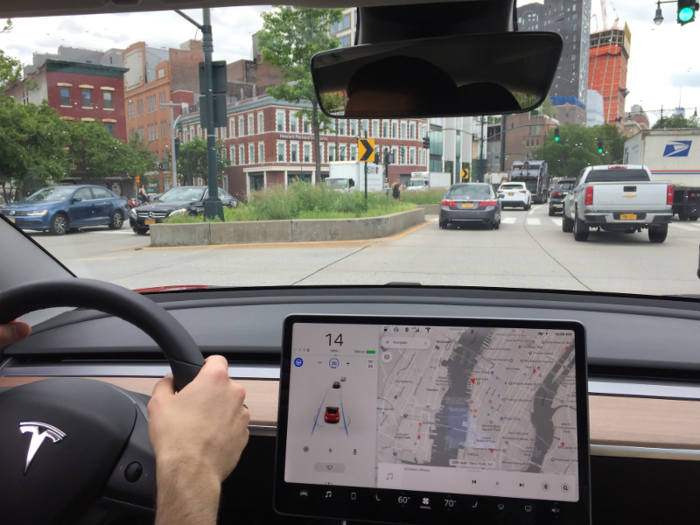

I had trouble letting the system handle any amount of driving without my input, even with my hands on the wheel and eyes on the road.
Read more: Videos showing Tesla's Smart Summon feature doing bizarre things have gotten the NHTSA's attention



To turn it off, you can either push the stalk up, press the brake pedal, or start turning the steering wheel yourself.



The former keeps a vehicle centered in its lane in areas where there are clear road markings. It worked well when I used it on this Model 3, but I could feel my attention starting to drift from time to time when it was on. Even though my hands were on the wheel and my eyes were on the road, I felt somewhat disconnected from the driving experience when I wasn't controlling the vehicle's speed or direction.


On one occasion, it felt like this Model 3's aggressive braking could have led to an accident if an inattentive driver had been following too close behind me. Another time, this Model 3 appeared to get confused by a pickup truck in the lane to my left that was not merging into my lane. The Model 3 I was in slowed down without having a clear reason to do so (there weren't any vehicles in front of me close enough to prompt such a move).

I had turned off autosteer, which kept me alert to the vehicles around me, but not having to constantly brake and accelerate the Model 3 myself removed much of the stress I would normally have felt in that situation.

I tested ProPilot Assist last year.

Sometimes, it would turn off in the middle of or just before a gradual turn on the highway, which meant that I would have to intervene immediately to prevent the Leaf from veering out of its lane. I preferred to control the steering myself.

That makes it difficult to be ready to quickly take control of the vehicle if autosteer can no longer read the lane lines, or if the vehicle doesn't see an obstacle in front of it.

Tesla's competitors are split on driver-assistance systems that to some degree control steering and speed at the same time but still require the driver to be ready to take over. Some companies, like Cadillac and Nissan, have developed systems similar to Tesla's. Others, like the Google spinoff Waymo, are skipping partial autonomy for systems that can drive without any human supervision.
My time with Autopilot made it clear that this debate will continue for years to come.
 US buys 81 Soviet-era combat aircraft from Russia's ally costing on average less than $20,000 each, report says
US buys 81 Soviet-era combat aircraft from Russia's ally costing on average less than $20,000 each, report says 2 states where home prices are falling because there are too many houses and not enough buyers
2 states where home prices are falling because there are too many houses and not enough buyers A couple accidentally shipped their cat in an Amazon return package. It arrived safely 6 days later, hundreds of miles away.
A couple accidentally shipped their cat in an Amazon return package. It arrived safely 6 days later, hundreds of miles away. 9 health benefits of drinking sugarcane juice in summer
9 health benefits of drinking sugarcane juice in summer
 10 benefits of incorporating almond oil into your daily diet
10 benefits of incorporating almond oil into your daily diet
 From heart health to detoxification: 10 reasons to eat beetroot
From heart health to detoxification: 10 reasons to eat beetroot

Copyright © 2024. Times Internet Limited. All rights reserved.For reprint rights. Times Syndication Service.